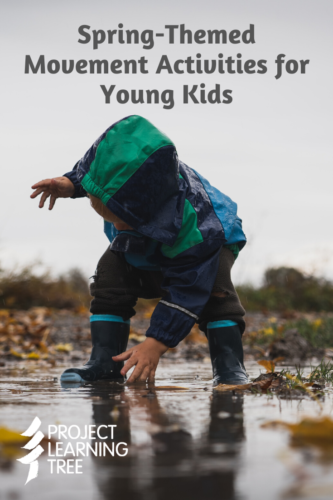
Spring is in the air, which also means that kids ages six and under are getting the wiggles and want to be outside.
It can be difficult to sit still when the world is in bloom—so why not help children by getting them moving and learning about the wonders of spring?
Enjoy these fun spring-themed movement activities that will get young children moving while also learning about the environment.
Especially beneficial for neuro-divergent students who focus and thrive outdoors, the following movement activities are all about nature—specifically the springtime topics of plants, seeds, and trees—and are sure to be a favorite with the children you work with.
1. Sorting Games With Leaves, Seeds, and More!
Sorting is an important math and science skill that students will need throughout their lives. Whether it’s classifying similar species together in science or counting similar numbers in math, the idea of grouping like things together is the same.
You can kick this activity off with a bit of forest bathing, which is a fancy term for taking in your natural surroundings with your senses—a great mindfulness activity! You can help your students connect with their surroundings by asking them to close their eyes and describe what they see, hear, or smell. Then take a walk with them and collect seeds, nuts, and leaves.
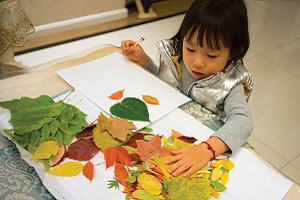
Once you’re back in the classroom, place bins for each item category you’ll be sorting throughout the entire room instead of just a table so your kids can still get some movement indoors. Students can place leaves in a bin by the window, seeds in a bin by the door, pine needles in a bin by the chalkboard, or different colored leaves in bins across the room.
Your class can also make a picture graph to show the amount of each item or color of leaves as they collect and count from each different bin.
Take a closer look at leaves with children using PLT’s early childhood activity, The Shape of Things, from PLT’s latest resource, Trees & Me: Activities for Exploring Nature with Young Children.
2. Simon Says… With an Outdoors Twist
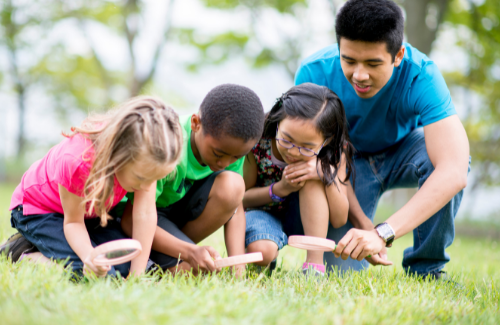
The possibilities with Simon Says outdoors are endless and endlessly fun! Get students involved with plants, trees, seeds, and other aspects of the natural world with a twist on the classic Simon Says game. This one will spark their interest in the natural topics you cover and get them laughing.
Simon says to plant a tree. Simon says to be a tree blowing in the wind. Simon says to water three plants. Hug ten trees. Examine a fallen nut and describe what you see. Collect as many fallen seeds as you before the timer sounds. Hop like a rabbit to the nearest tree. Walk ten steps in the dirt with your bare feet. Gently collect a bug in a jar. Identify cloud shapes while laying down in a circle… the list goes on and on!
3. Nature Yoga for Kids
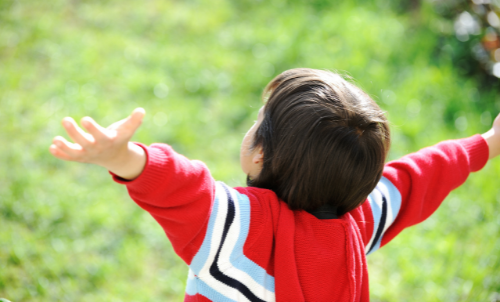
Engage your class in yoga poses that reflect the seasonal changes in weather and animals commonly found in springtime. For the frog pose, squat with your knees apart. For the tree pose, reach to the sky while grounding your feet to the earth. Lean into the rainbow pose by bending your body and arms like a rainbow.
Pink Oatmeal has also identified spring-themed yoga poses and affordable yoga pose flashcards you can purchase for your class. You can also use these cards to set up different yoga pose stations outside or inside your classroom for a yoga obstacle course.
Be sure to remind your kids to stop if something hurts them and that not everybody will be able to do every move, and that is normal.
4. Outdoor or Indoor Scavenger Hunt
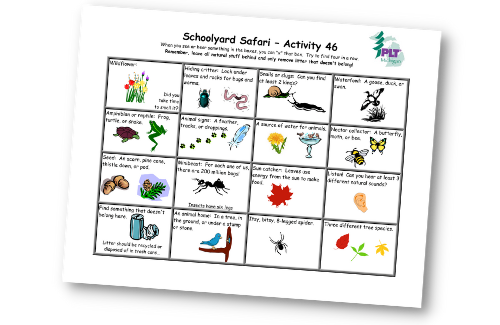
Set your students on the hunt by having them look for different plants, animals, flowers, and other items found in nature.
Check out this Nature Scavenger Hunt Grid for ideas on some basic living things to see, like ants, bark, or a spider web. This “Schoolyard Safari” bingo sheet from Michigan PLT is a great one to use, or you could always create your own grid or checklist to fit your specific grade level or topic.
Indoors, hide natural objects around the classroom and let your kids hunt for them. Create a treasure map for added excitement.
More great nature walk activities: Discover more engaging nature walk activities for young learners by visiting this PLT blog post. Explore how to fit a class garbage clean-up into a lesson about reducing, reusing, and recycling. Find tree-planting tips and worksheets, or see fun ways to investigate wetlands for microorganisms and bugs with “dip netting.”
5. Animal Charades
This game is simple but an absolute blast for kids. First, write a good variety of animals on pieces of paper. Then, pass a hat around the class and have students choose one. They’ll have to go around the classroom imitating the walk of whatever animal they picked without a sound and see how long it takes classmates to guess their animal. Test students’ knowledge about the graceful prance of a deer, how to hop like a cottontail rabbit, or leap like a toad.
6. Parachutes… Nature Style!
Rain Parachute
In this take on the classic gym parachute game, students stand in a circle or rectangle while lifting a parachute (or standard bedsheet). Lift it slowly up and down at first, then fast, and then challenge two people across from each other in the circle to crawl to the other side before the parachute (rain) comes down on them. Watch the excitement grow!
Giant Mushroom Parachute
To make a giant mushroom instead, practice lifting the mushroom dome parachute or bedsheet up and down a few times. Once your kids have the rhythm down, on the count of three, have them lift it as high as they can, kneel, and pull the edges down outside of them. This makes it super special for the kids to all be inside the parachute dome that looks like the inside of a mushroom!
Turtle Parachute
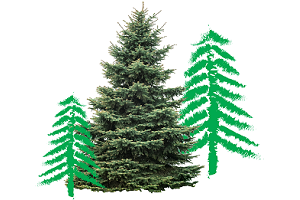
Once your class successfully pulls off the mushroom dome and is inside it, have them work as a team to move the parachute that is now a turtle using hands and knees to take it in a designated direction. This is also fun even when the parachute is lying on top of everyone, and they can’t see each other!
Blooming Flowers
Have a couple of seeds (students) lay underneath the soil (parachute or bedsheet). Celebrate the arrival of spring flowers with an adorable song like this one, and, when it gets to the punch-line of the flowers arriving, make sure the sheet is pulled off of your flower students!
Fox dens and mole tunnels
By incorporating chairs and tables, you can transform your turtle shell, mushroom parachute, or bedsheet into a fantastic fox den or mole tunnel for kids to burrow into!
7. What Time Is It, Ms. Owl?
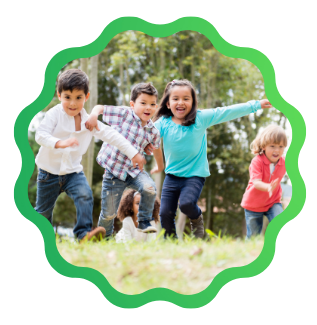
In this game, field mice (students) line up along a taped or drawn line either outside or in the classroom. One by one, each mouse asks, “What time is it, Ms. Owl?” Ms. Owl (hidden behind a cardboard cut-out or other object that is a stand-in for a tree) replies with a random hour of the day, like “4 o’clock!” The mice all take four steps towards the tree with the owl, no matter how big or small. The following student asks, “What time is it, Ms. Owl?” again, and the owl shouts another time (like “8 o’clock!”), and the mice take eight steps towards the owl.
The mice keep asking as they move toward or past the owl until the owl decides to fly out from behind the tree, flapping its wings and saying, “Snack Time!” Everyone runs back to the starting line as the owl tries to tag them. When the owl tags a mouse before it reaches the line, that mouse becomes the next owl or can join the owl in the tagging fun during the next round. However, if the owl doesn’t tag anyone, it remains the owl until they do tag someone.
If this is too alarming for your class, feel free to have Ms. Owl shout, “Bedtime!” and whoever is tagged lays on the floor, pretending to be asleep.
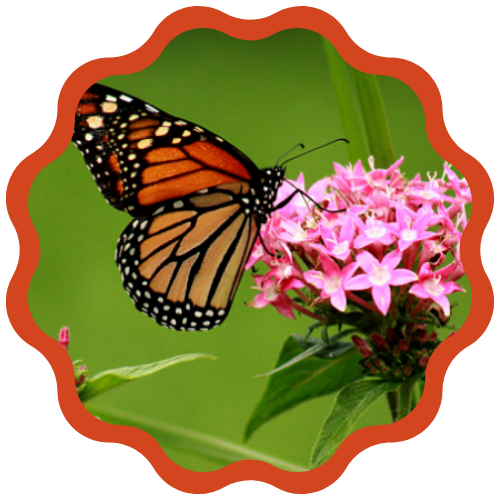 8. Connect the Plant and Animal Lines
8. Connect the Plant and Animal Lines
Create lines that form different shapes in the form of plants, trees, or animals on the floor inside with masking or painter’s tape. Have your students follow the lines in this connect-the-dots-like motor game until they reach the end of each shape.
9. Clap and Learn About the Great Outdoors
Concentration 64
Sing the song below as a class and choose a nature category like animals to start with. For example, the first person will say the first animal that comes to mind, followed by three claps. The next person continues with another animal and cannot repeat one that’s already been mentioned. Whoever takes longer than three seconds to say an animal is out.
Concentration (clap 3 times)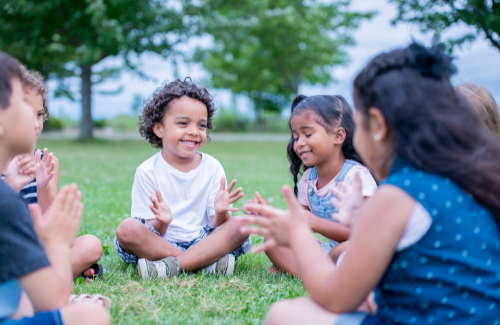
Sixty-four (clap 3 times)
No repeats (clap 3 times)
Or hesitations (clap 3 times)
I’ll go first (clap 3 times)
You’ll go last (clap 3 times)
Category is: _______ (clap 3 times)
Story Time Clap
Read a story to your class and get them to clap along in this perfect activity to build on their listening skills. Choose a specific clap word, like “daffodil,” and they must clap to the word whenever you mention it. Feel free to create your own story or tweak the difficulty level by doing multiple words or phrases. For example, if your words are “squirrel” and “nut,” you could really get your students clapping and listening even more! Try one of these wonderful stories about trees to clap along with.
10. Journey Through the Woods With Toddlers
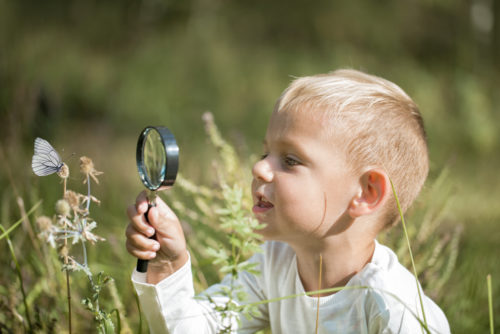
Take your group of toddlers outdoors, and be sure everyone brings their imagination. If you read a vivid story that takes place in the outdoors (like Red Riding Hood), pretend that you are in the forest where Red journeyed through. Explore with them and go under bridges, slide down hills, listen to the birds in silence, or whatever else you think would make an interesting physical connection with the natural world.
When exploring with children, make sure to remain within areas open to the public and away from prohibited areas.
Take it one step further and explore the sounds children observe on their walk with PLT’s Sounds Around activity for ages 1-6 from PLT’s newest resource, Trees & Me: Activities for Exploring Nature with Young Children.
11. Get Your Trees, Seeds, and Gardening Dance Moves On
Dances With Beans
Teach your kids about how they can grow seeds with this catchy “Can You Plant a Bean” dance tune. The song and choreography, created by the Dance n’ Beats research-based movement program, will have them dancing faster and faster… and faster!
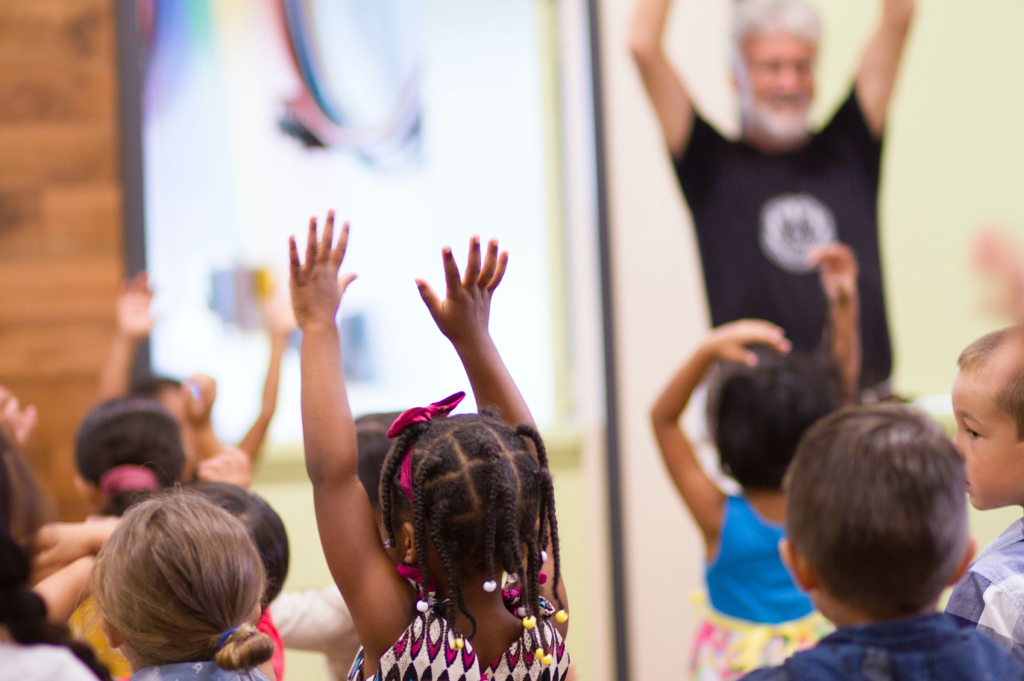 See the Trees Stand Dance
See the Trees Stand Dance
Your class will enjoy dancing–and relaxing– to this beautiful ballet and balance song about trees. Just check out See the Trees Stand by artist Curly Cath!
Making a Garden Dance
Join Dan and Nina from The Little Red Piano as Nina shows Dan– through relevant seated gardening dance moves– just how easy it can be to start a garden by sowing seeds, shoveling, and more.
Grow Like a Flower Movement Break
Follow along with Miss Cindy from Firefly Family Theater to see how tiny seeds require sun, rain, and more to grow into tall, amazing flowers.
Dance With Leaves
Have students move to the rhythm of music or invite children to move around like an animal as they find a leaf shape to stand on and imitate using The Shape of Things Group Experience from PLT’s newest resource, Trees & Me: Activities for Exploring Nature with Young Children.
12. Celebrate the Earth Through Music

Musical Toadstools
Students pretend they are frogs hopping onto toadstools in this Musical Chairs Game: The Nature Edition. Place pillows on the floor or use chairs for toadstools and, as you play music, have them walk (or hop!) in a circle around the toadstools until the music suddenly stops. Each time the music pauses, the frogs must sit on whichever toadstools they’ve hopped in front of. Frogs will have to leap to get a spot since you will have one less toadstool in the circle than needed each round. Each time a frog is left off a toadstool, they are out.
After you take away a toadstool, start the music again, and repeat as many times as it takes until one frog lands on the last toadstool and one is left standing. The frog who landed on the last toadstool wins.
Freeze Dance
Kids will love getting their springtime wiggles out on the dance floor to these great songs about planting, seeds, and gardening. The only rule is to dance away until the music stops… then freeze! Cheer your kids on to bring the energy up and let them know the sillier their moves and faces when they freeze, the better!
Prickly Pinecone
It’s the pinecone edition of hot potato! Pass a pinecone back and forth while playing music. Whoever has the prickly pinecone when the music stops is out.
Enjoy these other educational children’s songs about trees to pair with your lessons about them.
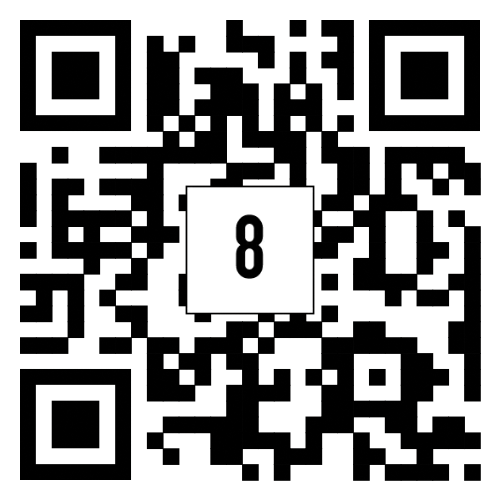
Dance Around a Maypole
People in many European countries celebrate the end of winter and welcome spring by dancing around a maypole. Pick any warm, sunny day and have students dance around a pole or tree (with six-to-eight feet of unbranched trunk) using soundtrack eight from PLT’s Trees & Me playlist. You can also attach 16-foot ribbons or strips of fabric, jingle bells, and garland.
Use PLT’s Best Buds activity for ages 1-6 to access the full Group Experience from PLT’s newest resource, Trees & Me: Activities for Exploring Nature with Young Children.
Did your kids enjoy any of these activities? Let us know which exercise you did with your little ones and how it went.
Have more spring movement activities? Let us know your go-to activities in the comments!



